Examples of French antiques under restoration, on site in Rhode Island, USA, in 2001 (By Bo Atkinson). Cement or really Ferro cement is the material. Naturalized textures are crafted into the surfaces. The collection belongs to an estate along the Rhode Island coast (USA). I was hired to travel to the site and restore the corroding collection which had begun to develop cracks in the cement and rust . Ferro cement was officially invented in France and many innovators have since evolved the art form in many diverse ways.
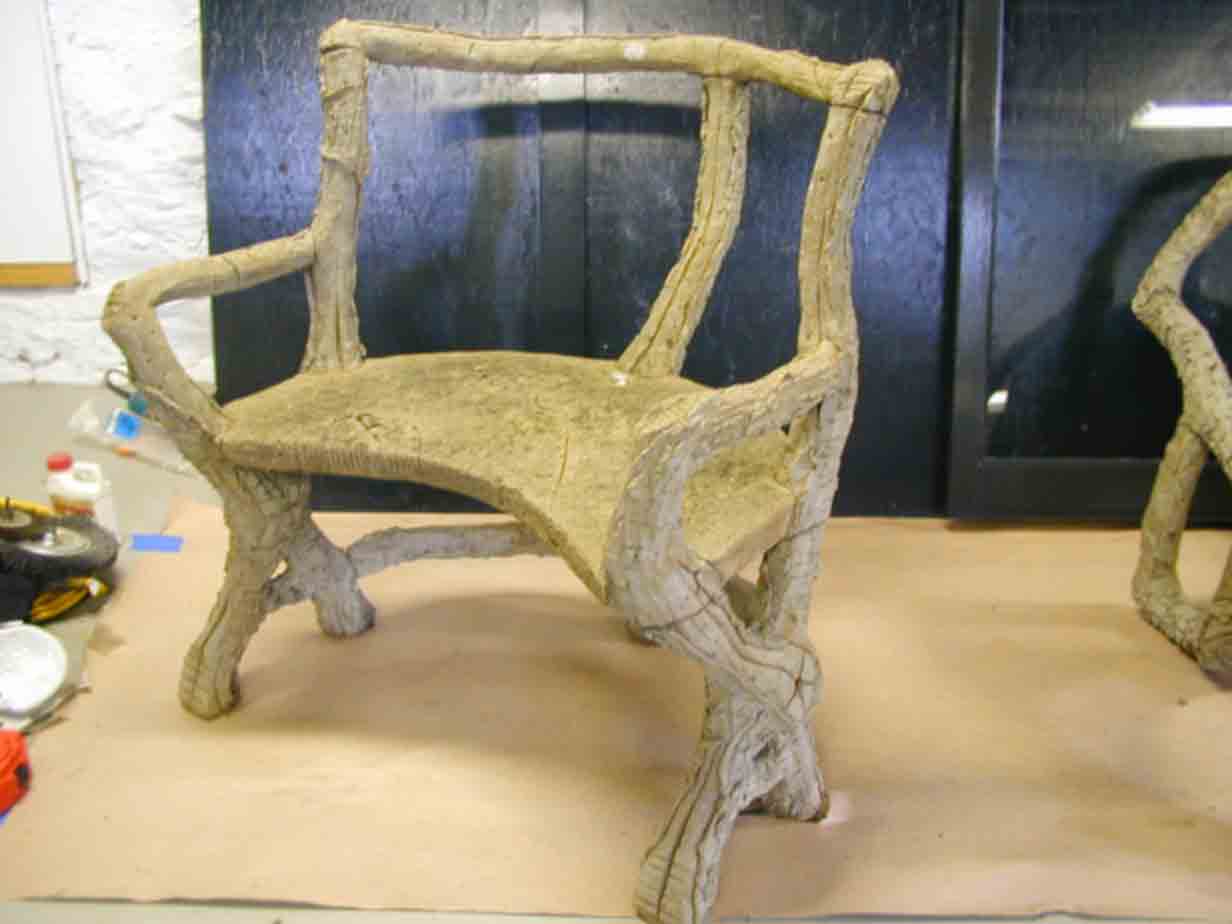
(Picture Above) A Lovely sculpted effect of branches form a bench which appears grown (like a shrub). Some of the sculpted crevices had developed damaging cracks. Cement generally shrinks according to the details of formulation and application. Shrinkage is challenging to completely prevent. Evolving technology continues to offer additives and treatments to avert crack formations in new cement or concrete. These Faux Bois pieces appear to have used very plain Portland cement and sand mixes. In general plain Portland cement has proven durable when applied properly.
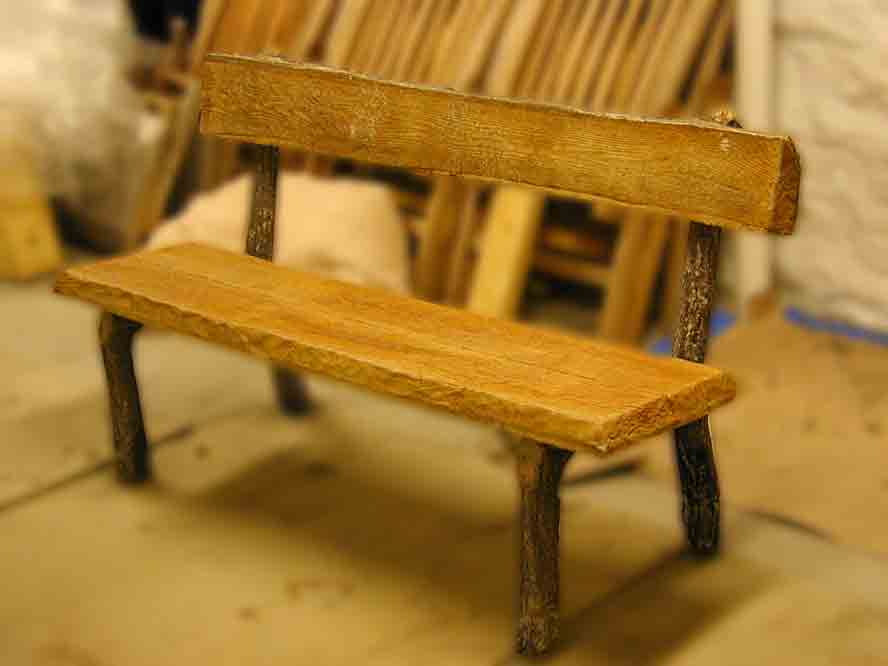
(Above) A more typical style of a planks in a bench. The quality of cement in all these pieces appeared normal, but the steel reinforcement presented two destructive influences. While cement can itself tolerate shrinkage and appear normal, shrinking cement cannot tolerate steel that does not shrink in unison. Normal shrinkage causes much initial cracking. The second destructive influence is caused by rust formation which can begin when shrinkage cracks admit water from rain or high humidity.
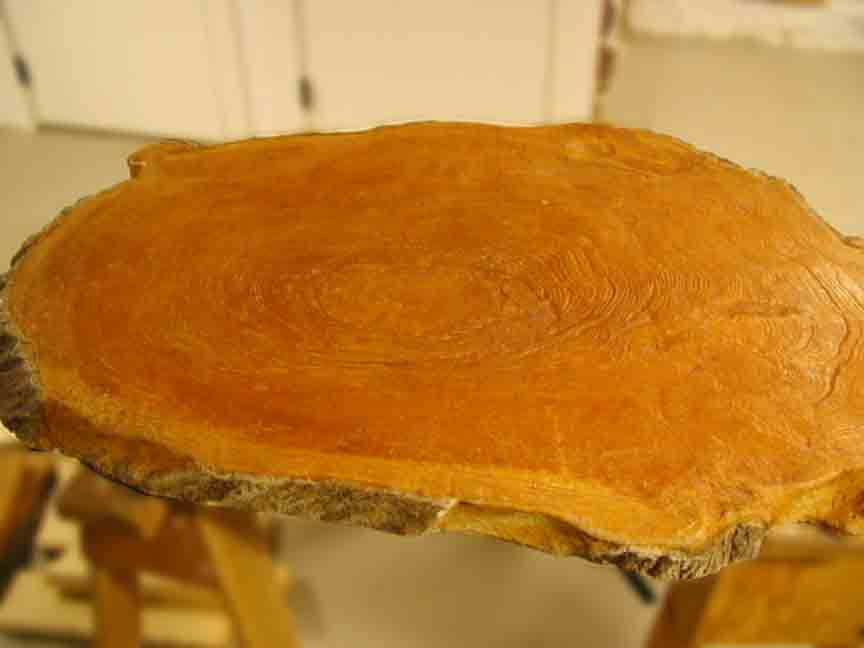
(Above) A beautiful texturing likely molded from a sawn log of large diameter, forms this table top. Even the bark has been sculpted to recreate the slice of log. Coloration was superbly crafted. Ferrocement is arguably a composition to minimize cement use and increase reinforcement use. When the reinforcement is fine wires instead of heavy steel parts, then normal cement shrinkage can better be tolerated. Popularity is also growing for strategies to "weaken" a cement product most strategically, to arrest cracking. This strategy uses very finely sized fiber additives which deflect larger crack formation into widely dispersed micro-fine sized "cracks" which are not connected. Instead of being cracks, they are expansion spaces at the microscopic level. Some fibers actually improve strength and perhaps also simply deflect stresses and thus prevent large cracking stresses, at least as a delay tactic.
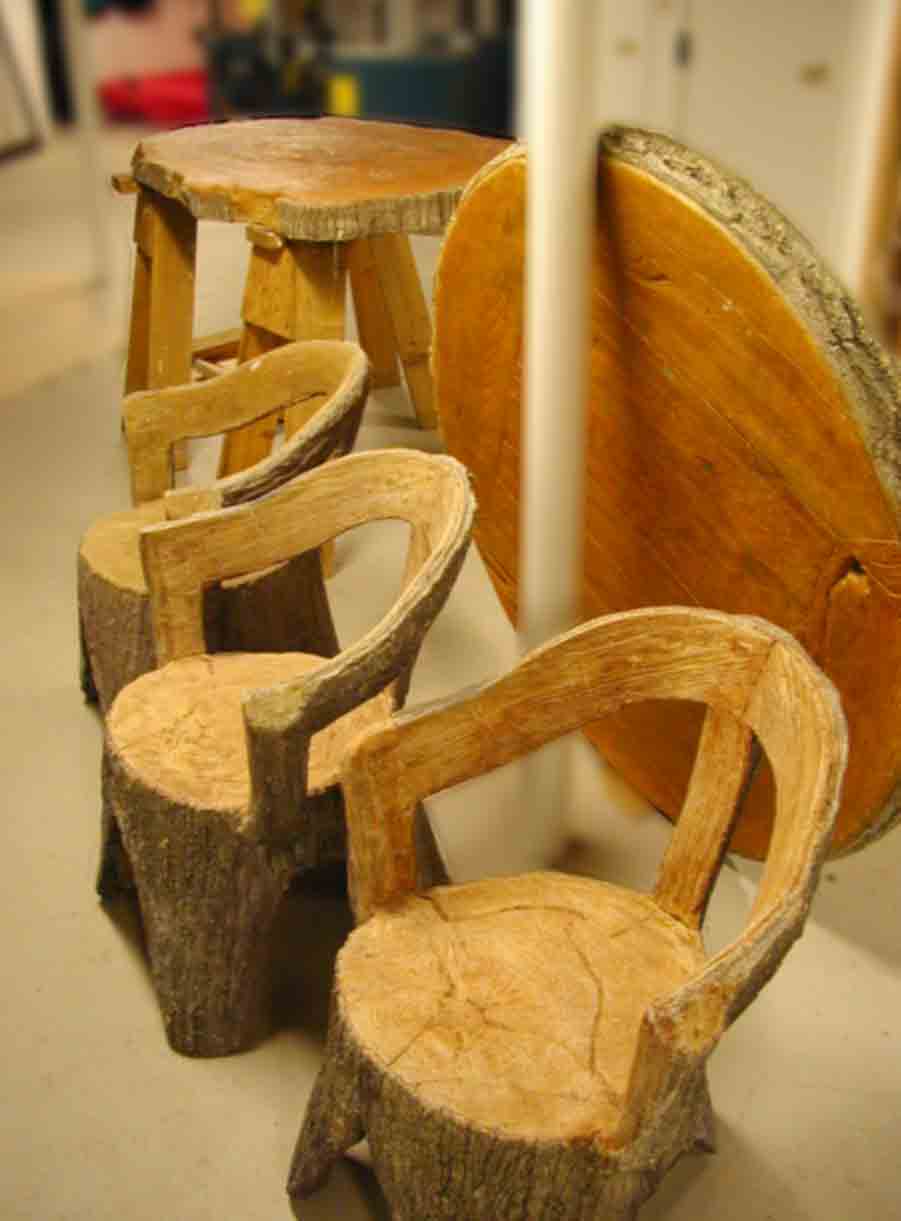
(Above) Stump like chair bases with back rests and another table top emulating boards fitted together. The antique effects of natural wood are excellent. The primary restoration effect here was to seek for cracks and seal them with varied sealants, to match the beautiful finishes. Cracks smaller than a pencil diameter often were sealed with quality caulking like urethane, having some colorants added to match the surface. Normal cement pigments were used primarily.

(Above) Finally we observe some damage possibly caused by a physical blow. We also see that the coloration is restricted to the surface, which suggests that high quality stains were used, in that the color has lasted , possibly since the peice3s were made. It might represent the efficacy of acid stains which are becoming popular today. This sort of damage required hand sculpting new cement to match the old. In addition to cement, an acrylic-latex additive was used in the mix. This type of additive adds just a little bit of strength but more importantly it improves the cement cure and the initial sculptor's bond (stickiness). Curing cement is tricky in that the new cement must be prevented from drying before the cure is finished (28 days is the official period recommended by manufacturers). The acrylic-latex additives furthermore forestall the drying and also accelerate the cure so that a full cure can be achieved in 24 hours.
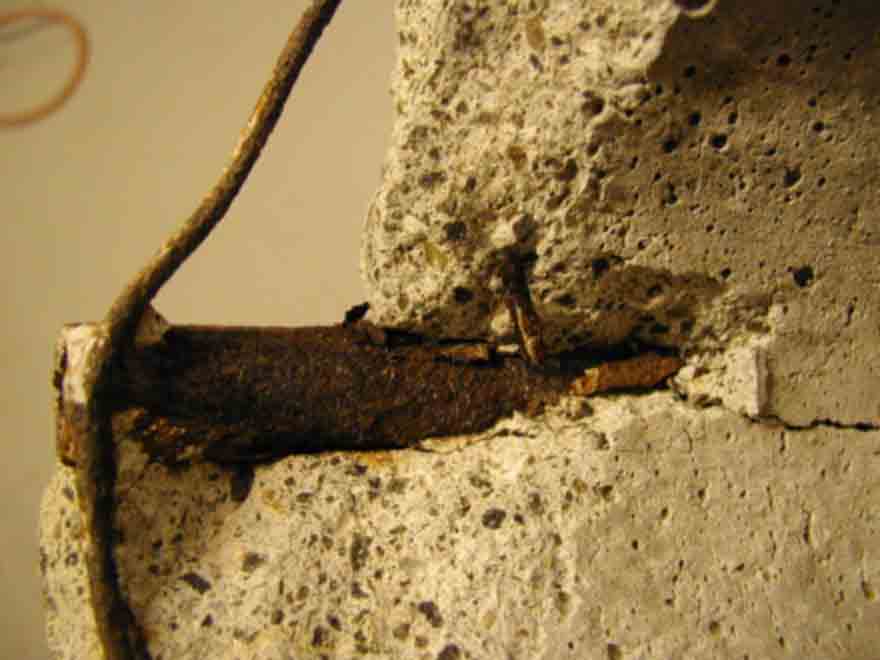
(Above) Next we can observe damaging cracks and breakage which reveals a composite framework. Steel tubing and thick wire are revealed. The tubing has rust flaking off. Such flaking formation actually expands dimensionally. Expansion bulges outward which itself will eventually cause more cracking in the cement. Cement highly resists inward compression but has very little tensile (or binding) strength. Steel has both strengths and it is the tensile strength which favors steel, as it is used in any construction. The job steel does is to bind as in wrapping a loose bundle, into one object and holding looser parts together as one object.
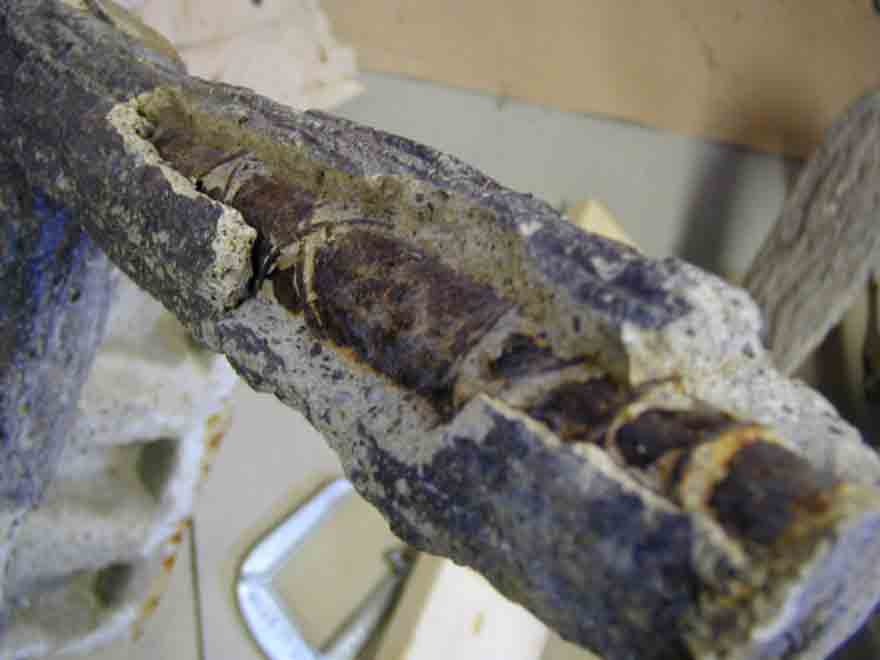
(Above) Finally furniture leg damage is revealed. Steel tubing again is seen, this time with wire wrapped around, both in clockwise and counter clockwise fashion. Thus "X" crosses are formed which provides more surface for the cement to bond with. The bonding is the normal looser bond cement posses and can never equal the bond between steel molecules and atoms. This steel arrangement may well have inspired the original reinforcement rod patterns. The damage here appears initiated by physical handling of the furniture, as the crusty flaking is much less evident than the previous photo. Rust staining is evident, but that has likely formed after the damage.
One last note i would add for restoration efforts. Are sculptures to be kept in moist climates or on moist lawns.... Be sure that the feet of such sculptures are kept water sealed, up top the ankles, ideally. I say ankles because moist grass can impart moisture which may wick it's way up porous stone like ferrocement sculpture.Of special interest here is that electrical charges are conducted along moist paths. Very subtle electrical charges can amplify corrosion. In fact two methods to protect against corrosion are named: "sacrificial anode" and "protective cathode". These methods might be a little cumbersome to employ, but in the case of priceless antiques, a sophisticated method could prove very beneficial. Extremely arid locations frequented by lightning may also benefit as well. Even if lightning does not directly strike an object, all objects are conduits of electrical charge which can at some level induce corrosion or internal unstable parts like ferrous metal.
Sit Down Gardening ! Ergonomic Nutrition? Seat- planters offer relaxing access instead of back bending tension. Long hours of bending over while gardening is simplified by sitting planters.
I will try to add new pages on my concrete sculpture. Here are some older ones: stone
bath, furniture , ![]() lantern,
gate, decorative concrete, pool ,
lantern,
gate, decorative concrete, pool , ![]() fountain , bridge, memorial,
ceremonial, bas-relief ,
fountain , bridge, memorial,
ceremonial, bas-relief ,![]() translucent dome, basin, birdbath , chair , table ,
translucent dome, basin, birdbath , chair , table ,![]() archetypal mask , Timeless
Statuary , Euro-Adobe
archetypal mask , Timeless
Statuary , Euro-Adobe
For my article on sand casting concrete sculpture, click here. I am very glad to hear inquiries about my availability to work creatively. I'm also glad to receive comments on my web pages, pro and con. It all keeps me focused on sharing my creative experience. Newer email: bo1@pivot .net
I